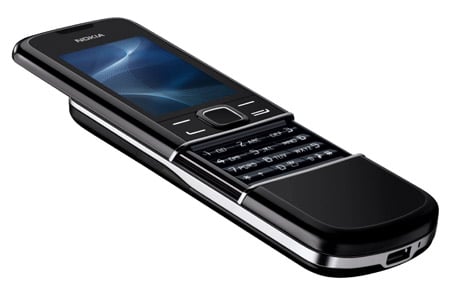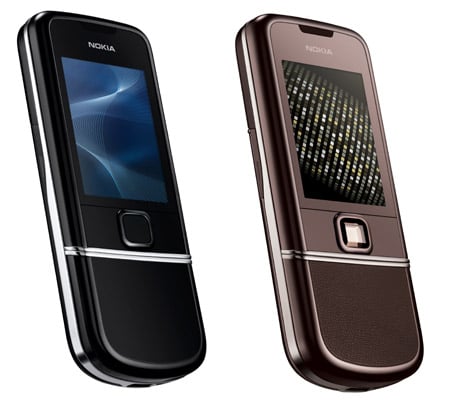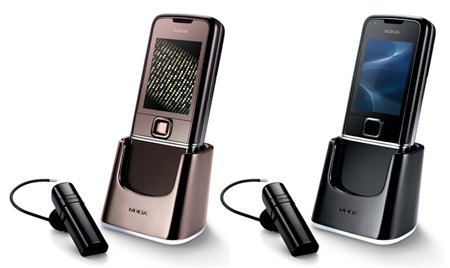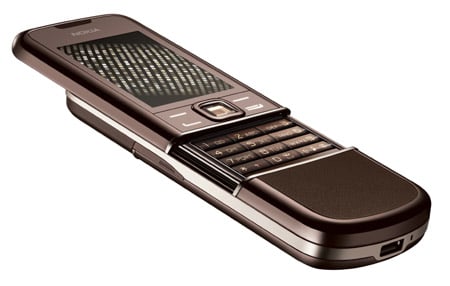Original URL: https://www.theregister.com/2008/04/03/review_nokia_8800_sapphire_arte/
Nokia 8800 Arte and Sapphire Arte handsets
Aimed squarely at the money-is-no-object mobile buyer
Posted in Personal Tech, 3rd April 2008 15:55 GMT
Review If you want to put your money where your mouth is, the Nokia 8800 Arte is a luxury sliderphone with a eyebrow-raising price tag that says more about you than your average Nokia ever could.
This pair of high-class handsets demand you splash the cash not for the latest smartphone functionality, GPS receiver technology or video call functionality - sophistication and quality are the wallet-tempting key words here, with these mobiles built to high specification in premium stainless steel and glass. Think minimalist chic rather than the overt attention-grabbing of other style phones.

Nokia 8800 Arte: heavy for a relatively standard-function phone
Nokia has introduced the 8800 Arte and 8800 Sapphire Arte in tandem as the latest in its series of luxury handsets. Both models have a similar design and specification – including 3G connectivity, a 3.2-megapixel camera, and media player with 1GB of internal memory – but the Sapphire version notches up the exclusivity level with a real sapphire embedded in the navigation pad, plus additional brown leather trim on the front and back.
Each comes boxed with an appropriately upper-class set of accessories, including a sleek Nokia BH-803 Bluetooth headset, leather pouch and a matching heavyweight desk stand. Strangely, though, there’s no stereo headset for music listening – an odd oversight when you’re shipping so much money for these phones.
Nokia doesn’t equate a premium phone with an all-but-the-kitchen-sink mobile. The 8800 Arte and 8800 Sapphire Arte aren’t smartphones or Sat Nav-enabled devices, nor do they have en vogue touchscreen functionality or HSDPA mobile broadband. Instead they use Nokia’s standard Series 40 user interface, albeit with some fancy wallpapers, graphics, and ringtones.
Although the 8800 Arte and Sapphire have 3G onboard they don’t do face-to-face video calling – their smooth fascias are unbroken by secondary front-facing cameras. The 8800 Arte comes in glossy black with tasteful chrome trim, while the Sapphire version is predominantly bronze and brown leather with chrome edging.
The first thing you notice when you handle the 8800 Arte-class is that they are much heavier than you'd expect – 150g at a normal phone size of 109 x 45.6 x 14.6mm, so they have an exceptionally solid feel. You may expect a reassuringly well-built phone for the price, but it is a real pocket-sagger, particularly for a relatively standard-functioning phone.

Niether the 8800 Arte (left) and Sapphire Arte (right) have front-facing cameras
The slider mechanism is top drawer, smooth as you like with a light spring action, and it makes a satisfying ‘clunk’ opening and closing. Closed, the lower part of the phone introduces a novel Nokia tap-to-see clock feature, a typically low-key way of checking time on an analogue clock face. Similarly unassuming, you can also mute an incoming call alert simply by turning the phone face down – a subtle way of dismissing unwanted calls.
Glide open the phone by thumbing up the display and the numberpad appears. The keys are nicely designed to make the most of a limited area – simply arranged and slightly curved to feel separate from each other.
Above these sit the phone’s main navigation D-pad and control keys; they appear backlit when the phone’s active, but are otherwise invisible. Minimalist it might be, but the button action is all standard issue Nokia Series 40, with the D-pad flanked by softkeys and Call and End buttons. The display is a bright, 2in QVGA (320 x 240 pixels) 16-million colour OLED screen; it uses the latest display technology but doesn’t offer any more screen real estate than other more junior Nokia Series 40 phones.
You could use Nokia’s Active Standby menu option, for easy fast-key access to features, notes and calendar reminders - but the default mode for this is off, presumably to maintain the minimalist look of its custom-made themes. You can still program your own shortcuts for the D-pad and softkeys, though.
The menu system is standard Series 40 too, which will be familiar to millions of Nokia users – an icon-based grid set-up for main headings, with a variety of sub menus beneath. There are no extra side buttons for starting up the phone’s music player or camera.
The only socket is a microUSB connector at the base of the phone, used for charging, USB cable connection and earphones hook-up. At this price, it’s a bit rich – and puzzling - not getting a set of earphones in-box, particularly as there’s no standard-sized 3.5mm headphone socket to plug in your own headphones. Instead you’ll have to source a microUSB pair or microUSB to 3.5mm adapter to enjoy music properly.

Turning the handset over actually mutes incoming calls
The 8800 Arte and Sapphire Arte have 1GB of internal memory onboard, which you can load up with music, videos, images or other content. Unfortunately, though, that’s your memory limit – there’s no MicroSD card expansion slot. This is another unwelcome surprise for a high-priced mobile, particularly when even many budget phones now allow you to swap memory cards, and the price of MicroSDs 1GB and above is so affordable. There’s no radio on this model either – another head-scratcher when it’s available on lower-spec Nokias.
Putting aside the lack of memory card expansion and earphones (we used a spare Nokia set), the music player’s audio performance can be pretty good, with very acceptable tune-playing ability. Tracks are organised into regular categories (playlists, artists, albums, genres, videos) and there are the standard Nokia Series 40 music player settings options, including equalizer adjustment.
Copying tracks is simple too, using the (supplied) USB cable and a PC with Nokia PC Suite software or dragging and dropping with the phone in data storage mode. You can also download and stream music or videos over the air rapidly via a mobile network portal, thanks to the 3G connectivity. Bluetooth is another file transfer option.
You’d expect a high-class camera performance with a top-end phone. The 8800 Artes has a 3.2-megapixel camera with autofocus, so you can achieve some sharp and detailed shots.
Outdoors this is fine, with some accurately coloured and decently rendered images. Indoors, in poor light, the lack of a flash dampens its performance, with increased picture noise evident making for grainier images.
The autofocus system does a good job – you can hold the capture button (the navi-key) down to lock on to a subject and release it to take the pic, allowing a bit of flexibility with the auto metering system. As usual, a bit of practice will get you better results.

We found ourselves reaching for the desktop charger after two days with moderate usage
At this price level, you have to be critical though; the camera is lacking in the low-light shooting and doesn’t have the sophistication or control of Nokia’s higher-end smartphone models like the multi-megapixel-packing N82 or N95.
With no dedicated camera buttons, the default mode for taking snaps is in portrait mode, though you can switch to landscape in the sub menu. You get a few setting adjustment options too - white balance, brightness, night mode – plus effects, a self timer (though there’s no mirror to frame self portraits), and multi-shot options. You can also change imaging quality settings, with six image size options up to the maximum 2048 x 1536 pixels level.
Video capture quality is good for a mobile phone, delivering VGA quality (640 x 480 pixels) top resolution recording at 15 frames per second, but it's not as smooth as the top shooters.
Most other features included on the 8800 Arte and Arte Sapphire are mostly standard issue for Nokia’s current crop of Series 40 handsets, such as the 6500 Classic and 6500 Slide, and 5610 XpressMusic device – all significantly cheaper models.
There are two web browsers to utilise the 3G capability, the Nokia native one, and the impressive Opera Mini browser Java application, which also provides Yahoo! search and Wikipedia plus Dictionary.com quick search options. Web browsing is swift with 3G and downloading content is speedy too, even without a HSDPA boost.
Nokia’s WidSets application comes pre-loaded, enabling you to get RSS-based updates on a set of onscreen widgets. This enables you to get web-based updates from your favourite blogs and websites without having to actively browse each time you want to check.

That's a real sapphire in the Sapphire
Nokia’s usual organiser functions are included – calendar, to-do lists, notes, calculator and various timer and clock functions – plus convertor and translator apps. A voice memo function, speaker independent dialling, voice commands and a text-to-speech convertor are included too. Naturally, the email facility includes support for regular attachments.
A Golf Tour game is loaded up for downtime amusement, while Nokia’s usual Download! app also offers a range of other games and content you can download for free or for a fee.
Top marks for the Nokia 8800 Arte’s call performance – it produced excellent quality sound and maintained signal levels commendably well. Estimated battery life is quoted by Nokia as giving up to 300 hours standby, or talktime of 3 hours 20 minutes on GSM networks or up to 2 hours 45 minutes on 3G WCDMA 2100 networks. That’s a typical performance for this spec level. In practice, we found ourselves reaching for the charger after two days with moderate usage. That desktop charger should come in handy, then, for heavyweight phone users.
Verdict
When you head into luxury product territory, the usual value for money benchmark becomes less significant to the buyer than the desirability factor. Does the 8800 Arte or Sapphire Arte justify such a hefty price tag? Unquestionably, Nokia has used premium materials that give a reassuringly expensive, high quality – and weighty - feel to these devices. The design is understatedly elegant too.
The under-the-bonnet features run-down wouldn’t convince us to spank our credit card, however. They have a reasonable set of functions, but most of these you can get on other Nokia Series 40 phones at half the price. Sure, they have 3G, a 3.2-megapixel camera and 1GB of memory - but as we found, you don’t get the latest cutting edge mobile technology despite the expensive price tag. And there’s no HSDPA high-speed 3G, face-to-face video calling nor expandable memory - and the camera is limited. Socketry and earphone arrangements aren’t convincing either if you want to play music.